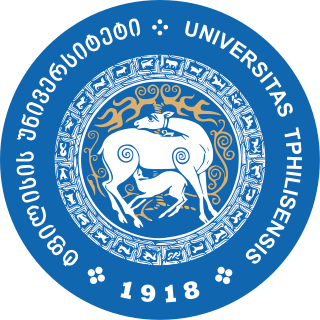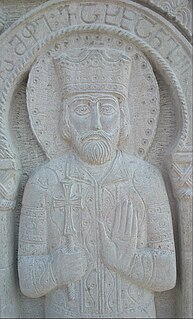Amanelisdze (Georgian :ამანელისძე) were a noble family in medieval Georgia with a surge in prominence in the 12th and 13th centuries.

Georgian is a Kartvelian language spoken by Georgians. It is the official language of Georgia. Georgian is written in its own writing system, the Georgian script. Georgian is the literary language for all regional subgroups of Georgians, including those who speak other Kartvelian languages: Svans, Mingrelians and the Laz.

The Kingdom of Georgia, also known as the Georgian Empire, was a medieval Eurasian monarchy which emerged circa 1008 AD. It reached its Golden Age of political and economic strength during the reign of King David IV and Queen Tamar the Great from 11th to 13th centuries. Georgia became one of the pre-eminent nations of the Christian East, her pan-Caucasian empire stretching, at its largest extent, from Eastern Europe and the North Caucasus to the northern portion of Iran and Anatolia, while also maintaining religious possessions abroad, such as the Monastery of the Cross in Jerusalem and the Monastery of Iviron in Greece. It was the principal historical precursor of present-day Georgia.
The 13th-century anonymous Georgian chronicle The Histories and Eulogies of the Sovereigns mentions the Amanelisdze, together with the Vardanisdze and Saghiridze, as participants of the sword-girdling ceremony of Queen Tamar upon her coronation in 1184. During Tamar's reign, the family, with the title of eristavi ("duke"), held sway over the fief of Argueti [1] [2] in western Georgia, which purportedly passed on to them from the Kakhaberidze. Upon the latter family's return to ascendancy, the Amanelisdze went in decline and disappeared from records. [3]

Tamar the Great reigned as the Queen of Georgia from 1184 to 1213, presiding over the apex of the Georgian Golden Age. A member of the Bagrationi dynasty, her position as the first woman to rule Georgia in her own right was emphasized by the title mepe ("king"), afforded to Tamar in the medieval Georgian sources.

Eristavi was a Georgian feudal office, roughly equivalent to the Byzantine strategos and normally translated into English as "duke". In the Georgian aristocratic hierarchy, it was the title of the third rank of prince and governor of a large province. Holders of the title were ex-officio commanders of a military 'banner', wore a distinctive dress, ring, belt and spear and rode a particular breed of horse.
The Kakhaberidze, archaically Kakhaberisdze was a noble family in medieval Georgia which held sway over the highland northwestern Georgian province of Racha from the 11th or 12th century to the 13th. The Kakhaberidze were a branch of the Liparitid-Baguashi, their dynastic name being derived from its early member Kakhaber known from a few inscriptions from Racha.
According to the 20th-century Georgian historian Ivane Javakhishvili, Queen Tamar's grandson King David VI (r. 1245–1293) was married, as his first wife, to a member of the Amanelisdze family, Tamar, who mothered three sons of David, all of them subsequently reigning monarchs. Tamar's background is not mentioned in the Georgian chronicles, but she is known from the surviving contemporary charters, one of which identifies her as "the daughter of Emenelasdze", a corrupted form of Amanelisdze, as posited by Javakhishvili. [4] The anonymous author of The Histories and Eulogies of the Sovereigns makes reference only to David's one consort, a Palaeologian princess from Constantinople. [5]

Ivane Javakhishvili was a Georgian historian and a linguist whose voluminous works heavily influenced the modern scholarship of the history and culture of Georgia. He was also one of the founding fathers of the Tbilisi State University (1918) and its rector from 1919 to 1926.

David VI Narin (1225–1293), from the Bagrationi dynasty, was king of Georgia in 1245–1293. From 1259 to 1293, he ruled the kingdom of Imereti under the name David I as a vassal state of Georgia.
A reign is the period of a person's or dynasty's occupation of the office of monarch of a nation, of a people or of a spiritual community. In most hereditary monarchies and some elective monarchies there have been no limits on the duration of a sovereign's reign or incumbency, nor is there a term of office. Thus, a reign usually lasts until the monarch dies, unless the monarchy itself is abolished or the monarch abdicates or is deposed.




